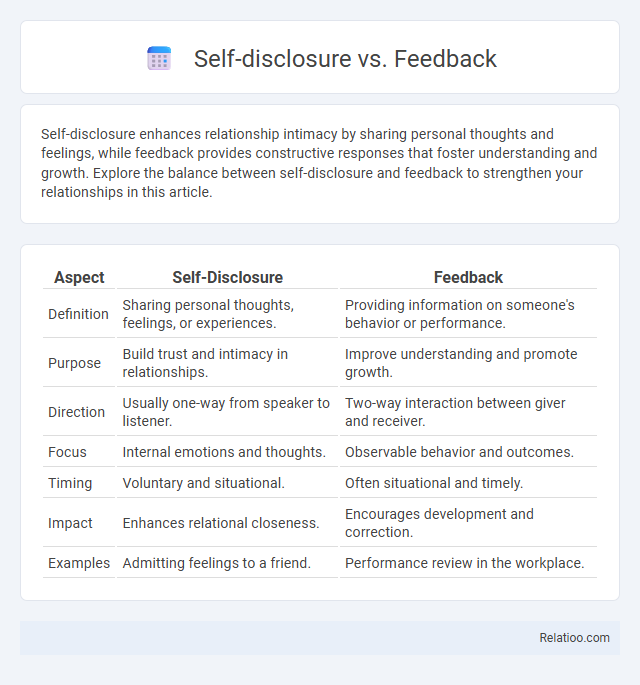Self-disclosure enhances relationship intimacy by sharing personal thoughts and feelings, while feedback provides constructive responses that foster understanding and growth. Explore the balance between self-disclosure and feedback to strengthen your relationships in this article.
Table of Comparison
| Aspect | Self-Disclosure | Feedback |
|---|---|---|
| Definition | Sharing personal thoughts, feelings, or experiences. | Providing information on someone's behavior or performance. |
| Purpose | Build trust and intimacy in relationships. | Improve understanding and promote growth. |
| Direction | Usually one-way from speaker to listener. | Two-way interaction between giver and receiver. |
| Focus | Internal emotions and thoughts. | Observable behavior and outcomes. |
| Timing | Voluntary and situational. | Often situational and timely. |
| Impact | Enhances relational closeness. | Encourages development and correction. |
| Examples | Admitting feelings to a friend. | Performance review in the workplace. |
Understanding Self-disclosure and Feedback
Understanding self-disclosure involves recognizing how sharing personal information builds trust and deepens relationships, while feedback offers external perspectives that promote growth and improvement. Your ability to balance these communication tools enriches interactions by fostering openness and constructive dialogue. Mastering when to self-disclose and how to give or receive feedback enhances emotional intelligence and strengthens connections in personal and professional settings.
Key Differences Between Self-disclosure and Feedback
Self-disclosure involves sharing personal thoughts, feelings, and experiences to build trust and intimacy, whereas feedback focuses on providing constructive information about someone's behavior or performance to facilitate improvement. Self-disclosure is inherently subjective and reflective, aiming to enhance relational depth, while feedback is objective and task-oriented, designed to influence future actions. Understanding these key differences is crucial for effective communication in both personal and professional contexts.
The Role of Self-disclosure in Communication
Self-disclosure plays a crucial role in communication by fostering trust and deepening interpersonal relationships through the sharing of personal thoughts and feelings. Unlike feedback, which provides evaluative responses aimed at improving or clarifying a message, self-disclosure builds emotional connection and mutual understanding. Your openness in self-disclosure encourages reciprocal sharing, enhancing the overall effectiveness and intimacy of communication.
The Purpose of Feedback in Interpersonal Relationships
The purpose of feedback in interpersonal relationships is to enhance mutual understanding and improve communication by providing constructive information about behaviors or actions. Feedback helps You recognize areas for growth, reinforces positive interactions, and builds trust through honest and respectful exchanges. Unlike self-disclosure, which shares personal thoughts or feelings, feedback specifically targets behavioral observations to foster connection and personal development.
Benefits of Practicing Self-disclosure
Practicing self-disclosure promotes trust and deeper connections by encouraging openness and vulnerability in relationships. It enhances self-awareness and emotional intelligence, allowing you to better understand and communicate your feelings. Compared to feedback, self-disclosure fosters personal growth through authentic sharing rather than evaluative responses.
Advantages of Constructive Feedback
Constructive feedback enhances personal and professional growth by providing specific, actionable insights that foster skill development and improve performance. Unlike self-disclosure, which primarily builds interpersonal trust and emotional connection, constructive feedback directly targets behaviors and outcomes, promoting continuous improvement. Effective use of feedback also reduces misunderstandings and strengthens team collaboration by creating an open environment for honest communication.
Barriers to Effective Self-disclosure and Feedback
Barriers to effective self-disclosure include fear of judgment, lack of trust, and emotional vulnerability, which can prevent authentic sharing and hinder communication. Feedback obstacles arise from defensive attitudes, unclear messages, and perceived threats, making it difficult for you to receive or provide constructive input. Overcoming these challenges requires fostering psychological safety, clear communication channels, and mutual respect to enhance both self-disclosure and feedback processes.
Strategies to Balance Self-disclosure and Feedback
Balancing self-disclosure and feedback requires clear communication and active listening to maintain trust and openness. You should share personal insights strategically to build rapport while offering constructive feedback that promotes growth without causing defensiveness. Employing empathy and timing your disclosures ensures that both your message and feedback are received effectively, fostering a healthy interpersonal dynamic.
Impact on Personal and Professional Relationships
Self-disclosure fosters trust and emotional intimacy in personal relationships, promoting deeper understanding and connection, while feedback primarily enhances communication and performance in professional settings through constructive criticism and guidance. Balanced self-disclosure enables vulnerability without oversharing, which can strengthen relationships, whereas effective feedback encourages growth and accountability. Over-reliance on self-disclosure at work may blur boundaries, while inappropriate feedback can harm morale, highlighting the need for context-sensitive communication strategies.
Best Practices for Integrating Both in Communication
Effective communication integrates self-disclosure and feedback by maintaining clarity, relevance, and respect for boundaries to foster trust and openness. Best practices include balancing personal transparency with constructive feedback, ensuring disclosures are appropriate to the context, and actively listening to responses for mutual understanding. Combining these elements enhances interpersonal relationships by creating an environment conducive to honest dialogue and continuous improvement.

Infographic: Self-disclosure vs Feedback
 relatioo.com
relatioo.com